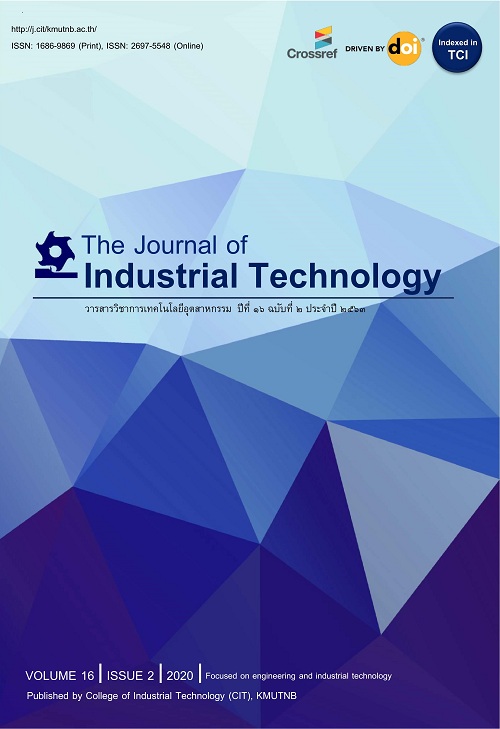Increasing Frozen Chicken Yields in the Pet Food Topping Process
การเพิ่มผลผลิตไก่แช่แข็งในกระบวนการผลิตเครื่องปรุงโรยหน้าอาหารสัตว์เลี้ยง
Abstract
Chicken breast and chicken tenderloin are the main raw material used in the topping production of pet food products, which is the core product of the company and also increased production capacity every year. But it was also found in the topping production including chicken thawing, chicken boiling, and flake production, occurring a high percentage of the weight loss of the main raw material (Drip loss). As a result, the cost of raw materials is increased and the percentage yield (%Yield) of the production target cannot be achieved. Therefore, this research aims to increase the yield of frozen chicken in the pet foodtopping process by applying DMAIC principles. The 3 solutions are proposed; (1) to change the method of thawing the chicken from set up immersion in a normal-water thawing tank change to electric defrosting with water and air, (2) the standard time for the chicken boiling process as the size of chicken breast and chicken tenderloin, and (3) to re-design a tray under the flaking machine. The results showed that in normal boiling, the yield of chicken breasts and tenderloin increased by 8.55% and 7.55%, respectively. In dry-boiling, the yield of chicken breasts and tenderloin increased by 1.70%. and 5.30%, respectively.
Keywords
[1] J.S. Roberts, O. Balaban, R. Zimmerman and D. Luzuriaga, Design and testing of a prototype ohmic thawing unit, Journal Computers and Electronics in Agriculture, 1998, 19, 211–222.
[2] P.S. Pande, R. Neuman and R.R. Cavanagh, The six sigma way: How GE, motorola and other top companies are honing their Performance, McGraw-Hill, NY, 2000.
[3] J. Antony, Six sigma in the UK service organizations: Results from a pilot survey, Managerial Auditing Journal, 2004, 19(8), 1006-1013.
[4] D.A. Edward and J. Maleyeff, The integration of lean management and Six Sigma. The TQM Magazine, 2005, 17(1), 5-18.
[5] J. Antony and R. Banuelas, Key ingredients for effective implementation of six sigma program. Measuring Business Excellence, 2002, 6(4), 20-27.
[6] J. Antony and C. Fergusson, Six sigma in the software industry: Results from a pilot study. Managerial Auditing Journal, 2004, 19(8), 9-11.
[7] N. Supphachai, Quality control, Se-education Public company Limited, Bangkok, 2008. (in Thai).
[8] K. Mongkol, Application of analytic hierarchy process to select quality improvement for defect reduction projects: A case study of air tank manufacturer, Journal of Engineering, RMUTT, Rajamangala University of Technology Thanyaburi, 2018, 16(2), 71-83. (in Thai).
[9] P. Sripuwong, Increasing efficiency productivity of filament IQF jumbo stick packing size 500 g., Thesis, Siam University, Thailand, 2018. (in Thai).
[10] R. Pakkanan and R. Puntaporn, Reduce waste of delayed on process powder beverage loading by apply DMAIC case study of powder beverage industry, Journal of Marketing and Management, 2019, 6(2), 67-81. (in Thai).
[11] N. Nikhil, P.G. Saleeshyab and H. Priya, Bottleneck Identification and Process improvement by lean Six Sigma DMAIC methodology, Journal Materials Today: Proceedings, 2020, 24, 1217–1224.
[12] M.H.F. Arifin, S.A Mustaniroh and S. Sucipto, Application of the Six Sigma DMAIC in quality control of potato chips to reduce production defects, Earth and Environmental Science, 2021, 924, 012056.
[13] T.J. Mason, L. Paniwnyk, J.P. Lorimer. The uses of ultrasound in food technology, Ultrasonics Sonochemistry, 1996, 3, 253-260.
[14] R.Y. Murphy and B.P. Marks, Effect of meat temperature on properties, texture, and cook loss for ground chicken breast patties, Poultry Science, 2000, 79(1), 99-104.
[15] S. Wattanachant, S. Benjakul and D. A. Ledward, Effect of heat treatment on changes in texture, structure, and properties of Thai indigenous chicken muscle, Food Chemistry, 2005, 93(2), 337-348.
DOI: 10.14416/j.ind.tech.2023.07.001
Refbacks
- There are currently no refbacks.






